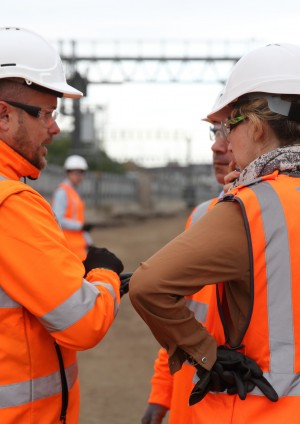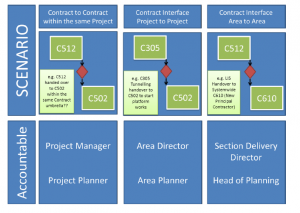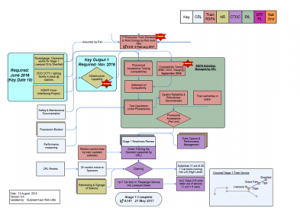
Crossrail Approach to Managing Interfaces
Document
type: Micro-report
Author:
Rob Little
Publication
Date: 26/02/2016
-
Abstract
Identification and definition of interfaces has been critical to the success of Crossrail so far, especially given the number of different Industry Partners involved in delivering the infrastructure. This learning legacy paper provides an overview of some of the key principles adopted by Crossrail in the delivery of the programme with a specific focus on interfaces; identification of interfaces; reporting and presenting of interfaces, including examples of key interfaces. It describes the importance of Anchor Milestones and Stage Diagrams in defining the strategic interfaces, Interface Milestones Schedules in tracking the forecast deviations against the baseline, all of which have been key to supporting successful delivery of Crossrail.
-
Read the full document
Introduction and Industry Context
Fundamental to the success of any project or programme is the definition and management of both internal and external interfaces and Crossrail is no different. Interfaces import risk into projects and on complex programmes such as Crossrail, successful delivery will be determined in part by Crossrail’s ability to manage them.
Crossrail’s Interfaces
The planning function in Crossrail supports the overall delivery function of the business and has established processes and deliverables that have been in place since 2011. The planning methodology is detailed in the Planning and Scheduling Handbook and planning of interfaces has been fundamental in the development of an integrated delivery schedule for the programme and are summarised here in this micro-report.
There are many interfaces between multiple contractors and stakeholders necessary to deliver Crossrail. They include:
- Crossrail contracts within the Central Section
- Network Rail
- London Underground
- Rail for London
- Docklands Light Railway
- Heathrow Airport Ltd
- Bombardier Transportation
Planning of Interfaces
As part of the standard planning methodology, interfaces are identified documented in project documents such as Interface Control Documents (ICDs) and contractual Key Dates. Individual projects are required to follow Crossrail’s Desk Top Instruction No.26 (Section 5.7 of the Planning and Scheduling Handbook)for managing project to project interfaces which stipulates how interface milestones are to be presented in an Interface Milestone Schedule within the Primavera P6 schedule database.
Figure 1: Typical Interface in the delivery of Crossrail’s Central Section.
Definition of Crossrail’s interfaces
The identification and definition of Crossrail’s interfaces is a continuous process however there are some key documents that have been produced that have strategically defined interfaces with Industry Partners e.g. Network Rail and Rail for London that fundamentally determined and therefore enable the management of the Crossrail programme of works. These are:
- Stage Diagrams
- Industry Dashboards
- Anchor Milestones
Stage Diagrams
These diagrams were developed in 2010 through a series of workshops to map out at a high level, strategic interfaces between Crossrail’s partners that are necessary to deliver Crossrail, who is responsible for delivering that part of the infrastructure and when.
Figure 2: Extract from Crossrail’s Stage Diagrams demonstrating some of the interfaces identified for Stage 1 of the opening.
Industry Partner Dashboard
Presented initially at the Crossrail Programme Board and latterly at the Railway Systems and Operations Programme Board the dashboard depicts interfaces between Industry Partners over a 12 month period that demonstrate how the industry is working together to deliver Crossrail. Its basis is not only derived from the delivery of Anchor Milestones (described below) but also in other areas that are necessary to successfully deliver the programme such as Agreements.
Anchor Milestones
Essentially the identification and definition of an Anchor Milestone relates to a significant interface on the Crossrail programme. Crossrail has identified over 350 Anchor Milestones since inception in 2010 and they have provided visibility on a project to project basis critical interfaces and an indication of how well Crossrail is working to achieve their completion.
Anchor ID Anchor Milestone Description MOHS Baseline Early Date MOHS Baseline Late date Actual/ Forecast Variance (BL Early – forecast) RAG Change from last period Axxx Cxxx – dd-mm-yy dd-mm-yy dd-mm-yy +/- days R/A/G ↑↓↔ Axxx Cxxx – dd-mm-yy dd-mm-yy dd-mm-yy +/- days R/A/G ↑↓↔ Axxx Cxxx – dd-mm-yy dd-mm-yy dd-mm-yy +/- days R/A/G ↑↓↔ Figure 3: Master Operational Handover Schedule (MOHS) Crossrail Anchor Milestone Periodic Reporting Template. Many Anchor Milestones define contractual interfaces.
Lessons Learned
Identification and definition of interfaces has been critical to the success of Crossrail so far, especially given Crossrail’s complexity and the number of different Industry Partners involved in delivering both the infrastructure and bringing into operation the Crossrail train service.
At an early stage in the delivery phase the establishment of the strategically pitched Stage Diagrams were a very effective demonstration of the ‘who does what and when’ and were very well supported in their development by Industry Partners and instrumental in defining, in particular the interfaces with Network Rail and the operator. These diagrams have continued to evolve over the years but the basic principles have altered little.
With so many interfaces to be planned and managed over so many projects Crossrail ability to deliver relies on the successful outcomes of these dependencies. From a planning perspective milestones have been identified by individual projects and have been managed in an Interface Milestone Schedule that allows for each identified interface to track its current delivery forecast against an annual baseline, deviations from which can be brought to the attention of senior management to affect decisions that may be required or mitigations to be put in place. This has been particularly successful in 2015 with the re-definition of interfaces between Crossrail’s systems contracts and Stations, Portals and Shafts projects through the identification of equipment rooms’ access requirements. These interfaces go to a level of detail beyond that provided in the individual contracts and have been captured in ‘Single Line Diagrams’ as well as individual interface milestones.
Redefinition of Network Rail interfaces to support Crossrails’ Early Dynamic Testing strategy is also working towards conclusion and a flexible approach will be required by both parties to reach a mutual acceptable outcome.
Desk Top Instructions capture the requirements for the management of interfaces and their milestones. This has been valuable to ensure consistency of approach across the programme.
The use of programme level ‘Anchor Milestones’ to define strategic interfaces has significantly supported the successful delivery of Crossrail.
Recommendations for Future Projects
Establish Strategic Goals and Dependencies
The opening strategy that Crossrail has pursued for the last 5 years was captured in Crossrail’s Stage Diagrams which were also used to drive a common understanding between Crossrail Partners of the scope, dependencies and timescales of mutual interfaces that are needed to successfully deliver Crossrail into operation.
Plan and Manage Interfaces using a Standard Methodology
Anchor Milestone don’t capture all interfaces on the Crossrail programme however they should be defined and selected to highlight those that that will be critical to determining a successful outcome.
Interfaces should be identified between projects and managed within the planning methodology in a consistent way. The use of an Interface Milestone ‘schedule’ that contains only interface milestones and inter-project links should be considered for future projects. This enables focused reviews of interfaces on a periodic basis.
Use Standardised Timetables
Using an annual re-setting of the programme baseline supports a flexible approach to programme management. Circumstances change over time and the definition and understanding of interfaces should be allowed to evolve during the course of a programme rather than rigidly maintaining definitions. Re-looking at interface definitions and required dates at interim points in time enable realistic and achievable goals to be established to deliver the same outcomes.
-
Authors
Rob Little - Crossrail Ltd, The Nichols Group
Head of Planning
Rob has worked with Nichols since 2002 holding senior planning positions on some of London’s most significant railway infrastructure projects including Metronet, Thameslink and Crossrail. Rob’s experience includes the construction of Hong Kong International Airport, infrastructure projects in southern China and telecoms experience to build global long distance capacity to support the growth of the internet.
Rob is a Chartered Mechanical Engineer with an MBA.

